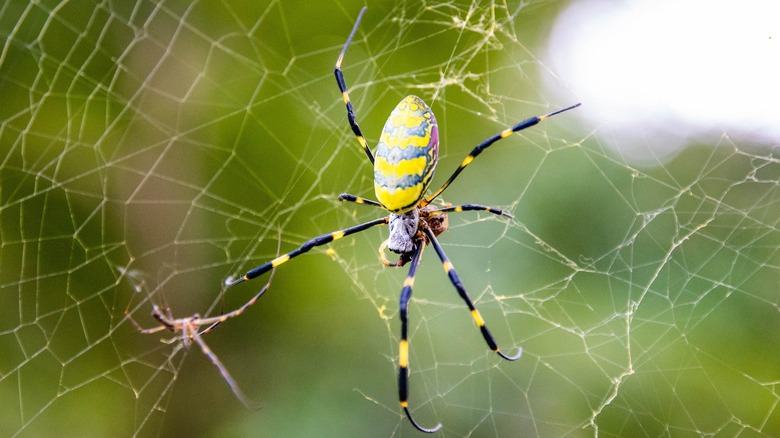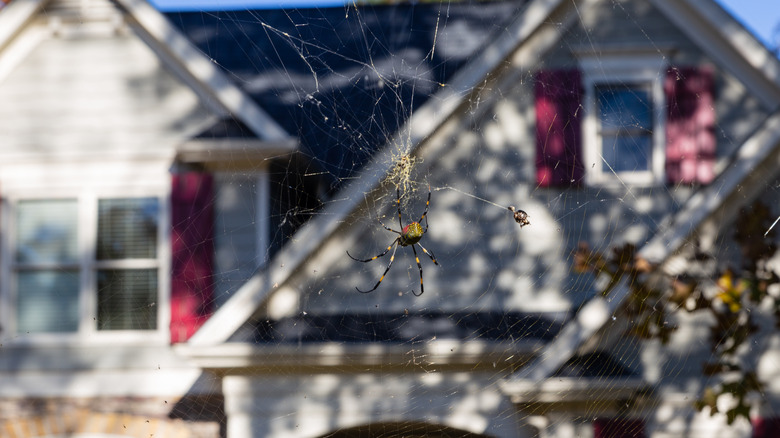Why Everyone Is Talking About Joro Spiders (& Tips For Keeping Them Out Of Your Yard)
Have you heard about a new spider species that's taking the internet — and the continent — by storm? Lately, hubbub has surged regarding Joro spiders. While it's true that you might be seeing this bright-colored spider more often, what's the word on the street about them? And how can you prevent them from coming near your home?
The Joro spider is a large web-weaving arachnid native to East Asia. It is closely related to golden silk orb-weavers (Trichonephila clavipes) and other members of the Trichonephila genus, sometimes lumped together under the broad nickname "banana spiders." Since first being spotted stateside in Georgia in 2013, the spider has been slowly expanding its range in North America. With about 4,000 spider species already estimated to be living in the country, adding one more to the list might not seem like a huge deal. But the Joro spider's bright body, terrifying appearance, and fascinating mode of transportation are enough to make anyone shudder. This venomous black and yellow spider can spin parachutes with its webs, enabling it to "fly" on the breeze for long distances.
We didn't have giant flying spiders on our BINGO card for 2024, either. Although they are invasive and can cover branches, street lights, telephone lines with their webs, Joro spiders may not be as evil or dangerous as they seem. Here's why everyone is dreading this scary creature, where the Joro spider is headed next, and what to do if you find one in your yard.
The rumors make Joro spiders seem terrifying
Most people are worried about the Joro spider simply because it looks scary. Luckily, a recent University of Georgia study published in Arthropoda shows Joro spiders aren't actually any more aggressive than other spider species. In fact, they're more likely to freeze in place than they are to attack. Although Joro spiders are technically venomous, their fangs aren't strong enough to pierce human skin. Even if the spider is able to deliver a strong enough bite, the effects should amount to little more than an itchy red bump that will heal on its own. Another reason people are panicking about the Joro is that it's rumored to fly on web parachutes. However, this is only true for the baby spiders, which are too small to pose a threat to humans or pets.
Residents in the southern United States may already be accustomed to finding a similar spider, the golden orb-weaver, in their yard. But for folks who live relatively large-spider-free lives up north, the pending invasion of Joros might feel like something out of a horror movie. Fall is usually the time of year that brings the most spiders into your house seeking warmth, and this is when Joro populations peak. Joros have a higher metabolic rate and can survive through colder temperatures. The Joro spider thrives in the warm, humid climate of the south, but some have already migrated north along the East Coast and could eventually spread across the country.
How to keep Joro spiders away, even if they're harmless
Not all Americans need to worry about Joro spiders just yet. In fall 2022, the spider has been reported in Georgia, South Carolina, North Carolina, Tennessee, Alabama, Maryland, Oklahoma, and West Virginia. Joro spiders remain suspended in webs where they'll wait for their prey, so trim low-hanging branches and shrubs, cut tall grass, and turn off porch lights at night, especially in fall, as these common mistakes might be attracting spiders to your house. While pesticides kill and repel Joro spiders, they'll cause more harm to your environment than good.
You can identify Joro spiders based on their wasplike coloring and several-inches-long legs. Their chaotic webs have been recorded as usually being low to the ground, but some reports also put them on lampposts, telephone poles, and between trees. You can choose to kill them, destroy their webs, or leave them alone. Everyone may be talking about invasive Joro spiders, but they may not actually be a big deal, and killing them isn't likely to help the environment much. "I think this is one of those 'canary in the coal mine' type species where it's showy, it's getting a lot of attention," said Hannah Burrack, an entomology professor at Michigan State University (via PBS). While Joro spiders could compete for food with native species, scientists aren't especially concerned about their impact at this time. Many see this invasion as just another symptom of bigger environmental problems caused by humans.


